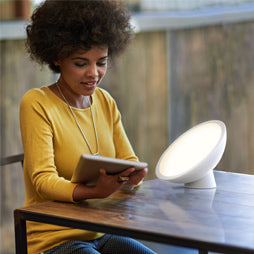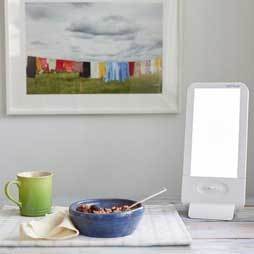SAD Light Therapy
Seasonal Affective Disorder Definition
Seasonal Affective Disorder (SAD) is a type of depression caused by the change in seasons. It manifests itself in many ways and has wide range and degree of symptoms.
These symptoms can differ from winter to winter, but are consistently associated with seasonal mood changes. SAD symptoms include:
- Oversleeping
- Sleepiness during the daylight hours
- Low energy
- Trouble concentrating
- Low to no motivation to exercise
- Carbohydrate cravings
- Weight gain
- Withdrawal from social situations
- A down, depressed mood during specific months
Once you are aware of the symptoms of SAD, then you want to assess whether your symptoms are mild or severe. More severe symptoms are often an indicator or SAD while mild symptoms are often indicative of winter blues, a milder form of seasonal depression. A clinical resource such as Dr. Norman Rosenthal’s book, Winter Blues, can help you assess to what degree you are experiencing seasonal mood changes and if you should seek the advice of a medical professional.
Latitudes Affect Attitudes
Populations who live farther from the equator are more likely to develop SAD. Why? Just like plants who wilt in fall and animals who hibernate in the winter, humans experience light deprivation, too.
The more sunlight that is lost in a region during fall and winter correlates to higher percentages of people who suffer from a seasonal disorder.
The Power of Light for Seasonal Affective Disorder
Production of serotonin (a.k.a. "The Happiness Hormone") is triggered by bright light like sunlight in the summer. Serotonin helps calm the brain’s response to stress and boosts overall feelings of happiness. This is why people tend to feel happier and more energetic on a bright, sunny day.
Serotonin has widespread effects on our mood and behavior, so when we are deprived of light, our mood, energy and sleep falter. Light deprivation and its symptoms - experienced by many due to climate or lifestyle - is a result of our body’s biological response to the lack of light.
Light therapy exposes you to a bright light that mimics the sun and is a natural way to boost serotonin. By integrating SAD light therapy into your daily routine, you can offset the affects of light deprivation and resulting seasonal disorders.
Bright Light Therapy
The good news is that bright, full spectrum light that triggers serotonin production are found in the Verilux HappyLight Therapy Lamps. Unlike drugs designed to treat depression (which can take weeks to kick in and find correct dosing), typically light therapy yields results quickly with daily morning use. Some people feel its effects immediately after using the light box for the first time while others in as little as two weeks.
Using a HappyLight is simple. Sit approximately 12-15 inches in front of the light for about 30 minutes each day while doing another activity like eating breakfast, working, reading, or using a computer.

HOW HAPPYLIGHT HELPS
"About each November, I become an unbearable grump. It starts somewhere near daylight-savings time. Last year I swore to myself I would spend the money to get a SAD lamp. ON THE VERY FIRST DAY I had it-I realized I didn’t want to leave my desk. I feel transformed and not so dreadfully crabby-it works!"
Jen | Minnesota
"My daughter managed undiagnosed Seasonal Affective Disorder symptoms for a number of years. Finally a friend recommended a Verilux Happylight and SAD light therapy and it made a HUGE difference. This is a definite must for anyone with SAD."
Dawn | Washington
"After several years of using anti-depressants I finally decided to try SAD light therapy with a happy light along with my medication. I noticed a difference very quickly and shortly thereafter stopped taking my anti-depressants all together. A happy light totally replaced my anti depressant medications and it works great!"
Kristin | Texas






